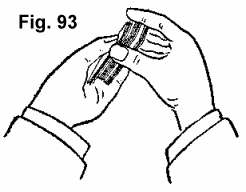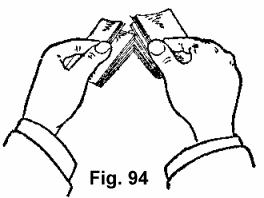IN THE first part of our book we described two blind shuffles for retaining either the upper or lower half of the deck in the same order, yet apparently shuffling the whole deck. Retaining the whole deck in a prearranged order is seldom or never attempted, or even desired, at the card table. But the conjurer performs many very interesting tricks through such an arrangement; therefore it is necessary to provide a blind shuffle that will not disturb any part of the deck. The following methods for retaining the entire order will be found sufficiently deceptive for his purpose, though by no means so perfect in appearance as the processes already described.
First Method
HOLD the deck in the left hand, crosswise, in the customary manner for the hand shuffle. Undercut with the right hand about three-quarters of the deck, and bring it down in the usual way of shuffling on top of the packet in the left hand, dropping a small packet from the top. Now, in raising the right hand again, still in the ordinary manner, seize the lower packet that was first left in the left hand between the right third finger and thumb, bringing it up with the rest of the cards, the packet that was dropped from the top now falling against the left fingers, concealing the fact that the under packet is withdrawn. (See Fig. 93.)

Now, with the left fingers tilt the packet over against the left thumb, and drop another small packet from the top of the right hand portion into the left hand between its packet and the fingers, still with the usual movement for shuffling. The left thumb now tilts the packet back on the other, and the right hand makes its customary movement downward, but this time drops the lower packet that is held between the third finger and thumb, by simply releasing the pressure of the third finger. Now the left hand portion is again tilted against the thumb, the right hand dropping another packet from the top, then the left hand packet is tilted back, and the right hand throws the balance on top. This process leaves the order the same, the deck having received but a simple cut.
The right hand makes five up and down movements in the ordinary or regular manner of shuffling, and without hesitating for an instant. The left fingers and thumb keep up the process of tilting its portion back and forth, allowing the right hand packets to fall above and below it. The actions of the right hand in bringing up the first packet from the left hand, with the first upward movement, and in releasing it again on the third downward movement (instead of dropping a packet from the top) are undetectable if the shuffle is performed with some degree of rapidity and smoothness. It is not at all difficult, but some practice is necessary.
The mode of shuffling over and under the left hand packet is commonly employed, and incites no notice. The shuffle may be repeated as desired, and should be varied with an occasional cut.
Second Method
THIS blind shuffle, or rather riffle, will require considerable practice to perform nicely, but it is worth it.

As the inner ends are brought together the two packets are spread somewhat, and the right little and third fingers twist out the bottom card first, and bend it in on top of the left hand packet slightly in advance of the rest. This prevents any of the other cards going wrong. The more fawns the packets are spread during the operation the more perfect the blind. The deck should be squared up rather slowly, the left thumb and fingers holding the deck; with the cards in their irregular condition, the right hand being released and pushing or patting the cards into position. Care should be taken not to riffle the corners far into each other. The merest hold is sufficient, and in fact if the packets can be held under perfect control the cards need not be interlocked at all, and the difficulty of the twisting out process is avoided. By slightly spreading the two packets as the springing or riffling of the sides is continued the appearance of the corners being interlocked is perfectly maintained.
This shuffle can be performed very rapidly, and with perfect control of the cards, and it is an excellent one for conjuring, as these performers never riffle on the table. But, as we have mentioned, it is difficult, and if the operator is not a skillful card handler he will find it quite a task to even riffle in the two packets, and this is the simplest part of the operation.
When this riffle is alternated with the foregoing shuffle it requires very close scrutiny of a very knowing card expert to detect the fact that the operation is a blind.
Third Method
THIS is another form of the second method. The deck is seized with the thumbs and fingers at the ends instead of at the sides, the little fingers going under the sides, the positions being identical, only that the deck is turned endwise.
When the deck is separated into the two packets the thumbs riffle the inner corners together, the left fingers are shifted across the bottom, the right thumb spreads the top cards over the left hand packet, and the right hand brings the outer ends of the two packets towards each other, twisting out the interlocked corners and placing the right hand packet again on top in much the same manner.
In this method the packets are easier controlled, and it is hard to say which is the better. But we think for conjuring purposes the more the methods for blind shuffling are varied the greater are the probabilities of convincing the company that the cards are genuinely mixed; providing always, that the several methods employed appear the same as those in common every-day usage.
Fourth Method
THIS is a very barefaced blind, simple, extremely easy, and surprisingly deceptive when cleverly performed.
Rest the deck on its side in the left hand in the usual position for shuffling, but hold the first finger against and along the end. Under cut about half the deck with the right hand, the first finger on the top side, and make the ordinary movement to interlock or force the right hand cards down among those in the left hand, bringing the sides together for that purpose. Allow a few of the cards from the top of the right hand packet to drop down on top of the other packet, but prevent them from going quite to the left palm with the left thumb. Now keep up a constant lateral movement with the right hand, shifting the packet rapidly lengthwise about half an inch each way, as though forcing the two packets to interlace, but really dropping the upper cards on top of the left hand packet, by holding the right hand packet slightly diagonally over the lower one, so that the inner corner of the right hand packet is just over the side of the lower one. Drop the top cards over in this manner until all are apparently interlocked about half way or more, then strike them on the top side with the fingers held flatly, driving them down even, and square up the deck.
The first finger held against the end and the first or top cards of the right hand packet, going over immediately as the sides are brought together, effectually conceal the ruse. If the process of actually interlocking the cards is tried it will be seen how perfectly the action can be imitated. An occasional cut tends to increase the deception.
Fifth Method
THIS process is very much employed by many clever card conjurers who ought to know better, and we include it only because it is in common use and to suggest its rejection. It consists in pushing small packets alternately from the top and bottom of the portion held in one hand to the bottom and top of the portion held in the other. The deck is held in the left hand and several cards are pushed over by the left thumb into the right hand. Then the left fingers push several cards from the bottom on top of the right hand cards. Then the left thumb again pushes several from the top, but these are received under the right hand portion. The left fingers now push several from the bottom to the top of the right hand portion, and so on until the left hand is empty. This clumsy juggling might prove satisfactory if performed by an awkward novice before a parcel of school children, but it appears simply ridiculous in the hands of a card conjurer, who, it is presumed, knows how to shuffle a deck in the customary manner, and with at least the degree of smoothness that any ordinary person might possess.
